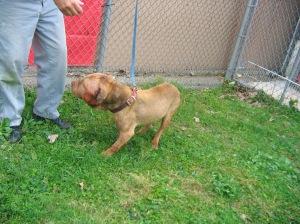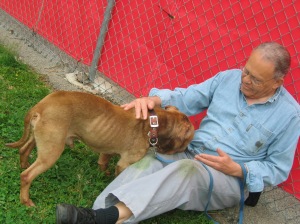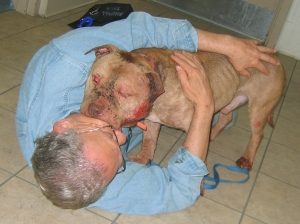Dog Grief
There are countless reasons why dogs are considered to be man’s best friend. They offer love, loyalty, and companionship, and anyone who has ever formed a special bond with a dog can attest to the symbiotic relationship between humans and canines. But what happens to a dog when he loses his best friend?
“When an owner passes away before her pet, it can be a confusing, sad, and difficult period, even if arrangements have been made for the animal to be taken care of by someone else,” says Russell Hartstein, a certified behaviorist and dog trainer based in Los Angeles.
It’s not unusual for dogs to grieve the loss of a person they’ve bonded with who is no longer present. While they might not understand the full extent of human absence, dogs do understand the emotional feeling of missing someone who’s no longer a part of their daily lives.
Because we can’t communicate with our dogs to explain when a loss occurs, certain indicators — such as a change in routine, or the absence of their owner’s sensations (sight, sound, smell) — convey that something is different.
“My definition of grief is that a surviving animal shows distress through behavior that is markedly divergent from his routine,” says Barbara J. King, professor emerita of anthropology at the College of William and Mary and the author of “How Animals Grieve.”
While we can’t say for sure whether the feelings a dog has when experiencing an emotional loss mirror that of a human’s, Dr. Marc Bekoff, professor emeritus of ecology and evolutionary biology at the University of Colorado Boulder, says there is now solid evidence from brain imaging studies that similar areas of dogs’ brains light up when they’re feeling parallel emotions to those of humans.
No two dogs are alike, so the way in which they grieve — and for how long — can differ. In order to decipher a dog’s emotional state after losing a loved one, it’s important to keep an eye out for certain signs, as they can affect a dog’s health. Although there is no concrete way of knowing exactly how a dog processes grief, there’s no denying the sadness expressed through behavioral changes. Anxiety and stress can present themselves in a variety of ways. Signs to be aware of include:
• Panting
• Whining
• Barking
• Pacing
• Fidgeting
Jme Thomas, executive director at Motley Zoo Animal Rescue, explains that dogs need to figure things out on their own and work through feelings when experiencing loss or grief. Other indicators of grief include:
• Loss of appetite
• Weight loss
• Lack of energy
• Listlessness or clinginess
• Loss of interest in physical activity
“Dogs are highly intuitive and sensitive, more than people give them credit for,” says Thomas.
In June 2014, Constable Dave Ross, a Canadian general duty officer and police dog handler, lost his life in the line of duty. His service dog, a German Shepherd Dog named Danny, stood alongside him during his time on the force. Throughout Ross’ funeral, the loyal canine whimpered next to his master’s casket. This is just one example of many that speaks volumes to the feelings a dog experiences after losing his owner.
Like us, dogs go through a grieving period. While there isn’t one specific approach, being sensitive to a dog’s needs can go a long way:
• Be aware of routines and try to stick to them
• Provide comfort by spending more time together
• Give extra affection — touch increases your bond
• Play his favorite game and increase exercise
“I have no doubt that dogs miss us as much as we miss them, and like us, they need time to heal from a deep emotional loss,” says Sally Morgan, a holistic physical therapist for animals and humans.
How long a dog grieves varies, but with time, most recover emotionally. At the first sign of decline in physical or emotional health, consult a veterinarian to ensure the symptoms of grief aren’t masking those of another illness.
How Do Dogs Grieve Human Death?
Pets may also show signs of loss and mourning in ways that the family may not recognize. Although somewhat different, they do feel the loss of loved ones. Many have a significant degree of attachment to their owner that leads to anxiety and distress when even short-term separation is thrust upon them, let alone bereavement.
Perhaps, the most famous dog-grieving story of all time is that of Greyfriars Bobby, a Skye terrier owned by a Mr. John Gray of Edinburgh, Scotland. Mr. Gray passed away in 1858 and was buried in Greyfriars Churchyard, Bobby was one of the conspicuous mourners. As time went by he never forgot his deceased master. Every day for the next 14 years until his own death in 1872, Bobby spent each night lying on his master’s grave come rain, hail, and snow. In honor of Bobby’s devotion, a statue and water fountain was erected to his memory in 1873.
Which Dogs Suffer from The Loss of Their Human Owner?
Dogs that have the hyper-attachment syndrome of separation anxiety are likely to be hard hit following their owners’ demise. Cardinal signs of this all-too-common condition, affecting up to 15 percent of dogs in the United States, are as follows:
• A checkered history of earlier neglect or multiple owners
• Excessive following behavior (“Velcro dogs”)
• Pre-departure anxiety as owner prepares to leave
• Barking, whining or howling immediately after the owner’s departure
• Destructive behavior only in the owner’s absence (and often directed toward doors and windows)
• House soiling only in the owner’s absence
• Loss of appetite when the owner is gone
• Depression/inactivity in the owner’s absence
• Self-directed licking behavior in the owner’s absence (e.g. lick granuloma) or other repetitive, compulsive behavior
• Excessive greeting behavior on the owner’s return
A score of 5 out of 10 of the above possible signs confirms separation anxiety. Some dogs with separation anxiety are so bonded to one person that if that person leaves the dog with other people in a crowded room he will display full-blown signs of separation anxiety. Such a dog will not take well at all to his owner going away on a trip or, indeed, to the permanent separation caused by death. The dog will panic at first and will eventually become depressed. While we can’t ask a dog how he feels, we can (and do) sometimes see all the visible signs of depression in bereft dogs that we see in a recently bereaved or otherwise depressed person.
Clinical Signs of Mourning in Dogs
Here are some signs that dogs are mourning a human loss:
• Lack of energy and interest
• Absence of play
• Listlessness/moping
• Loss of appetite/anorexia
• Reduced social interactions
• Increased daytime sleeping
• Nighttime restlessness/insomnia
• Weight loss
In people, post-bereavement depression following the death of a loved one usually begins to decrease. Sometimes it lasts 2 months, and sometimes it lasts longer, requiring medical or psychological help. The same is true in dogs. Some will eventually get over their loss and form new bonds whereas others enter a seemingly interminable funk. The latter cases present a therapeutic challenge.
Treatment of Dogs for Bereavement-related Depression
• Where possible, allow time to heal the wounds and merely supply appropriate supportive therapy. Make sure the dog continues to eat and drink, even if this means assisted feeding of favorite foods.
• Provide company during the daytime and at night. Have the dog sleep in the bedroom with his caretakers/remaining human/animal family.
• Provide distractions during the day such as toys, delicious food treats, games, excursions and so on, so that the dog is gainfully employed and entertained. Some coaxing may be necessary.
• Attempt to interest the dog in interacting with people or dogs. Sometimes a visitor dog to the house will stimulate the affected dog’s appetite and activity by a process known as social facilitation.
• Daily exercise is extremely important as it has a calming, soothing, and mood elevating effect. Aerobic (running) exercise is best if this can be summoned.
• Medication, as a last resort, in refractory cases. Human anti-depressants work well in this situation. Either older tricyclic anti-depressants like amitriptyline or imipramine, or more modern anti-depressants like fluoxetine (Prozac®), sertraline (Zoloft®) and paroxetine (Paxil®) can be used. Each has its own unique advantages in terms of mood elevation and stabilization; and each has its own slightly different therapeutic profile and list of potential side effects. Remember, these drugs must be prescribed by a veterinarian – doses for humans are very different from what dogs are prescribed.
Following acute loss of a closely bonded owner, dogs can suffer the pangs of separation anxiety or depression just as people do. The extent of the suffering is directly proportional to the strength of the bond with the owner and is a function of the dog’s reliance and perceived dependence on that person. Owners who feed into a dog’s intense dependence on them are more likely to have dogs that do not cope well when left alone for any reason. The emotional pain dogs feel on their owners death is an extension of, and extreme, protracted version of separation anxiety. While we all enjoy a close bond with our pets, and children for that matter, it is as well to prepare them to stand on their own four/two feet (respectively) so that they are not adrift should anything happen to us.





